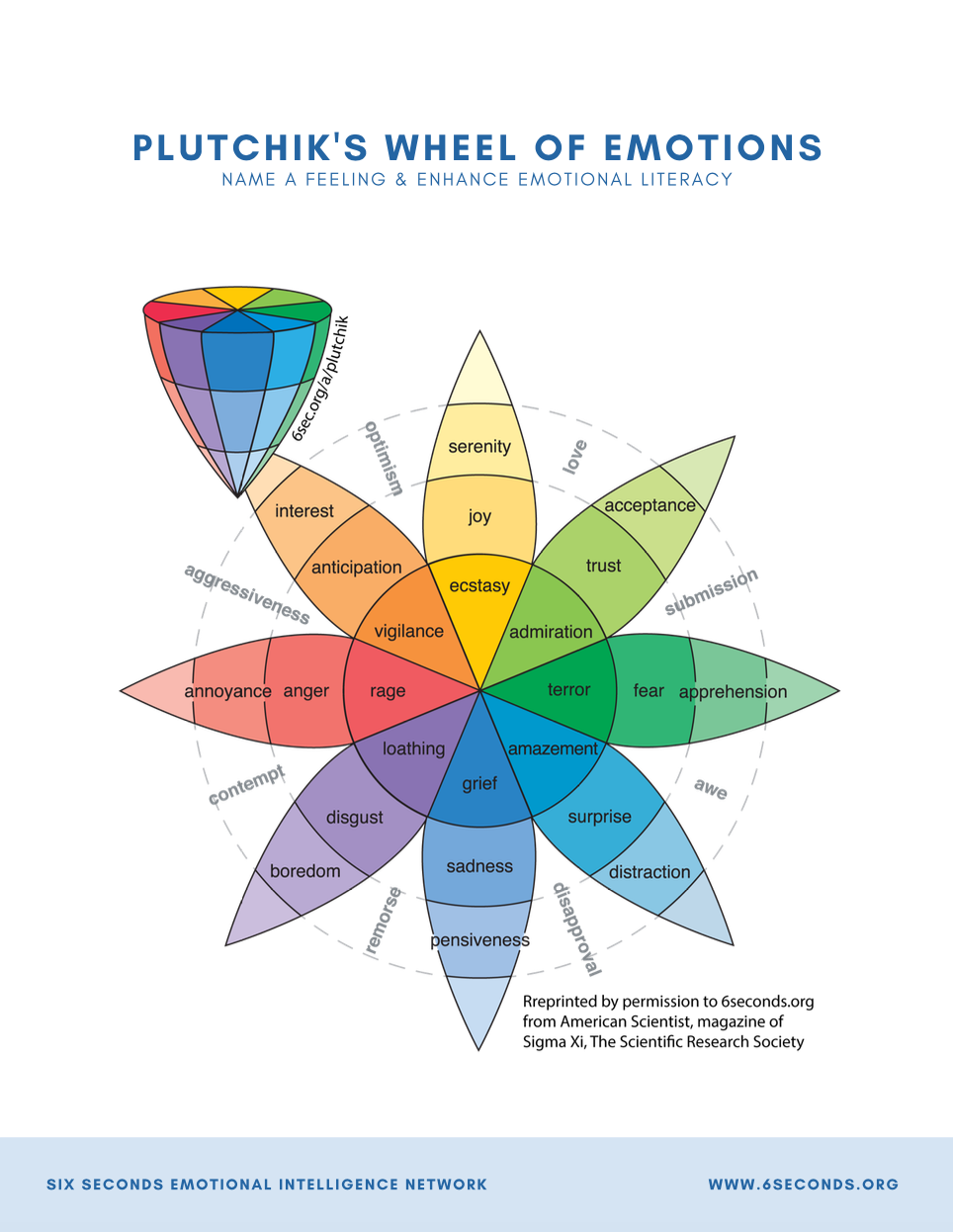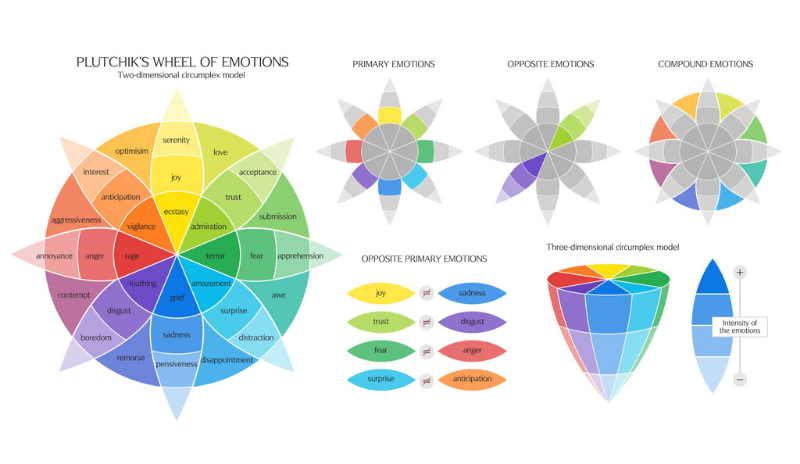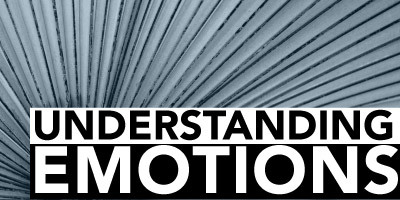Plutchik’s Wheel of Emotions: Exploring the Emotion Wheel
Emotions can be confusing! But what if you could explore them in an emotion wheel, and dig deeper with a simply powerful emotions list? The Plutchik Model of Emotions provides a simply logical way to make sense of feelings. Plus! At the bottom of this page you’ll find our top emotions resources, and a form to get your free emotions list with dozens of emotions explained.
What you’ll find on this page
➔ An interactive version of Plutchik’s Wheel of Emotions
➔ A free interpretation guide for the Plutchik wheel
➔ A free, downloadable PDF version of Plutchik’s Wheel of Emotions
➔ Free resources to learn more about emotions and emotional literacy, including the Six Seconds Model of Emotional Intelligence
The Feelings Wheel Defined
Psychologist Robert Plutchik created the Plutchik Model shown above. It shows there are 8 basic emotions: joy, trust, fear, surprise, sadness, anticipation, anger, and disgust. Plutchik’s wheel of emotions organizes these 8 basic emotions based on the physiological purpose of each. The model is actually the little “ice cream cone” which unfolds to the emotions wheel.
As you’ll see below, this framework helps bring clarity to emotions, which can sometimes feel mysterious and overwhelming. To improve your understanding of emotions, Plutchik’s wheel of emotions is a great place to start – and we included an interpretation guide below!
So, what do all those colors and petals mean?
Download Plutchik’s Wheel of Emotions Free
Want a PDF version of Plutchik’s Emotions Wheel? Just fill out the form below and we’ll send you a free copy for your home, office or classroom.

Interpreting Plutchik’s Wheel of Emotions
Primary: The eight sectors are designed to indicate that there are eight primary emotions: anger, anticipation, joy, trust, fear, surprise, sadness and disgust.
Opposites: Each primary emotion has a polar opposite. These are based on the physiological reaction each emotion creates in animals (including humans… Plutchik studied animals!):
- Joy is the opposite of sadness. Physiology: Connect vs withdraw
- Fear is the opposite of anger. Physiology: Get small and hide vs get big and loud
- Anticipation is the opposite of surprise. Physiology: Examine closely vs jump back
- Disgust is the opposite of trust. Physiology: Reject vs embrace

Combinations: The emotions with no color represent an emotion that is a mix of the 2 primary emotions. For example, anticipation and joy combine to be optimism. Joy and trust combine to be love. Emotions are often complex, and being able to recognize when a feeling is actually a combination of two or more distinct feelings is a helpful skill.
There are also tertiary feelings, not shown on the feelings wheel, that are a combination of 3 (and maybe some feelings have 4 or more parts? Let us know what you think in the comments below),
Intensity: The cone’s vertical dimension represents intensity – emotions intensify as they move from the outside to the center of the wheel, which is also indicated by the color: The darker the shade, the more intense the emotion. For example, anger at its least level of intensity is annoyance. At its highest level of intensity, anger becomes rage. Or, a feeling of boredom can intensify to loathing if left unchecked, which is dark purple.
This is an important rule about emotions to be aware of in relationships: If left unchecked, emotions can intensify. Herein lies the wisdom of enhancing your emotional vocabulary: it’s the bedrock of effectively navigating emotions.
Plutchik’s wheel of emotions helps us look at literacy through a broader lens. Literacy means “a person’s knowledge of a particular subject or field.” So enhancing emotional literacy means not only having words for emotions, but understanding how different emotions are related to one another and how they tend to change over time.
You can read Robert Plutchik’s explanation of his model of emotions in an article that was originally published in American Scientist in 2001 and can be read on Springer International Publishing AG.
The Six Seconds Model of Emotional Intelligence
Improve self-awareness, make better decisions, and connect to purpose.
Want a quick, powerful tool to get started? Download the Emotions List: Emotoscope Feeling Chart.
One of our core beliefs is that there are no “bad” emotions. Emotions are data – signals about threats and opportunities. To that end, the Feeling Chart lists the purpose of dozens of emotions.
Explore the neuroscience of emotions, 7 amazing facts about emotions and more free emotional literacy resources:
What’s New? Don’t Miss the Latest in Emotional Intelligence
What’s new in emotional intelligence?
From Enemy to Ally: How Eric Pennington Changed His Relationship with His Own Emotions – and Found His Life’s Purpose
How emotional intelligence helped Eric Pennington transform corporate life setbacks into strengths – and find purpose in both work and life.
Emotional Intelligence at Work: In the Era of AI, What Happens to Human Skills?
Who’s winning the artificial intelligence race: machines or people? Research finds AI investment leads to disinvestment in human skills
Helping Others Achieve Overall Well-being and Healthy Connections: How Emotional Intelligence Guided Pamela Barker’s Career Path Growth
Pamela Barker’s journey began with healing bodies, but it was her discovery of emotional intelligence that unlocked her true purpose: helping others achieve overall well-being and healthy connections. From her days as a physical therapist to becoming a passionate EQ coach, Pamela’s story is one of transformation, resilience, and the power of connection. Her experience shows that real change starts from within.
Emotional Intelligence at Work: Exploring the Principles of Exceptional Leaders
Check out these 7 valuable leadership lessons to be the best leader you can be and bring the best out of people.
Harnessing Emotional Intelligence: How Sara Canna Supports Employees and Transforms People’s Lives at the World Health Organization (WHO)
Emotional intelligence is more than just a buzzword—it’s a transformative tool that can reshape how we navigate challenges, build relationships, and thrive in demanding environments. Discover how Sara Canna brought EQ to the World Health Organization, empowering employees to manage change, stress, and personal growth.
3 Winning Strategies for Successful Change Leadership: Coaching with Emotional Intelligence
Can coaching tools help you lead successful organizational change? Here’s how to build team ownership and drive better outcomes by applying emotional intelligence for a coaching mindset.
- Enhance Emotional Literacy - July 13, 2023
- Plutchik’s Wheel of Emotions: Feelings Wheel - March 13, 2022
- Technology Loneliness: EQ Tips from Daniel Goleman - October 24, 2020








this enlighten my understanding.
The inability to regulate emotions can negatively impact all interactions as an adult in any environment.
All the best
Awesome website helped a lot to prepare for my tcl speech and drama examination
It is a great website because there are so many knowledge and informations
Feeling something good and enlightening
The information I found to be to be helpful in many ways
Always open your eyes to see what comes
Thank you for this assessment i feel confident for my 5 characteristics
Please send me updates on new articles
Hey Jeff, you can sign up for our newsletters here: https://www.6seconds.org/emotional-intelligence/subscribe/
please can i receive a free copy of the Plutchik’s Wheel of Emotions
Its a grate website there are so many knowledge and informations
This is good
Knowledge
glad I found this.
I always feel amazed about the things I experienced for once but I’m afraid to do things that I didn’t know what will gonna cause.
Im interested in then Plutchik’s Wheel of emotion wheel. Can you tell me when i can get one. I’m studying psychology and i would like to have one. Thank you for your time and help.
Good
do you offer this studies in Spanish?
Hi Xavier, please go to https://esp.6seconds.org/ for all of our offerings in Spanish.
My PhD is in color psychology, and I have a question that I would like to ask, when I do this emotion wheel, is there a connection between the background color and the emotion?
Great article! I’d love to cite this for my thesis but can’t see an author or date anywhere? Is anyone able to help with this?
Hi Robyn, we’re glad you have found this useful for your thesis. The publication date is August 11, 2020. The author is Six Seconds. Let me know if you need anything else!
Is the Plutchik Wheel of Emotions encompass all emotions, or is it a work in progress? I ask because I did not see other states of being I consider emotions (e.g. melancholy, hopelessness, etc.) in the wheel. Also, how would something like apathy fit?
Good question!
What’s Going down i’m new to this, I stumbled
upon this I’ve found It absolutely useful and it has
helped me out loads. I hope to contribute & help different customers
like its aided me. Good job.
Could you fix the diagram?
Is it working now for you?
I do love it!
Hello,
Where can we find the interactive Wheel you launched in August this year? It is quite common for the website to change and not to find articles.
Please let me know in a dedicated link where if the Interactive animation of the wheel.
Thank you,
Madalina
It loaded..:D..yeeey.
Hi Madalina – here’s the shortcut: http://6sec.org/a/plutchik — it’s on the top of this page.
🙂
Love the information and how the words and emotions grow stronger towards the middle of the circle. It really made me realize how our emotions can escalate
i should know my self very good & control my feeling to success in work & life
The interactive model is not displayed fully on the page and you cannot use it as is at the moment. You can only click on the very tip of the model, the light yellow point.
It takes a really long time to download. It’s working now
We had some issues with the system but now seems stable
Why the purpose and meaning of emotions is not downloading.
Where does Nervous fit in to the emotional wheel
Sorry about the download, emailed you! “Nervous” would probably be in the Fear section?
How to express to your emotion
The more we understand our emotions and their relevance the easier it is to ask ourselves, “Is this just my wrong thinking?” As educators it is crucial that we understand not only our student population but who we are too.
This information is not very clear to me at this point.
The emotion wheel shown (Plutchik’s) is interesting and useful, but is missing many common sensations we all experience in life, such as compassion, hunger, and so on. I’d suggest to look at the Pan-Affect Chart, which aims to better cover all of our pleasant and unpleasant feelings (without going too overboard): https://sudism.org/pan-affect-chart/ Cheers, Pierre.
Behaviors come from the disregulation of emotions.
I agree that self awareness is essential to the success in the workplace. The inability to regulate emotions can negatively impact all interactions as an adult in any environment.
Only “aggressiveness” and “submissiveness” are not emotions. They are behaviors which come from patterns of thinking and emotions such as anger/frustration/fear/etc.
I disagree. I think a person can feel aggressive, like they want to act aggressively, but not act on it. Perhaps a better term would be irritable, tense, reactive. I think submissiveness should just say submissive.
I view this a bit different. For me, Love is abstract. I then conclude that Aggressiveness and Submissiveness are also abstracts. The emotions that contribute to them in the color part of the wheel is what is exuded or rather mirrored out from the person. Also realizing, that the mirror is from those they associate who provide a mirror to them and thus the message their subconscious is receiving…making the emotion your friend, giving it a personality, giving it a smiley face or other, then telling it and asking it… “Thank you X for showing up, what are you hear to tell me?”
This is the most important question we can ask ourselves when looking inward at our mirror… Me: Thank you Anger (emotion) for showing up, what are you here to tell me? Answer: I’m here because I am being blocked from finding Love (the abstract). Me: Okay, thank you for that. What activities/actions can I do to gain more emotions that surround Love? … what activity/actions can I do that are Joyous to me? What actions can I do to create warmth in myself so that I may gain “Trust”…what learning can I do to become more “accepting”…perhaps mirror work will help? perhaps building qualities around Trust, Acceptance, or Serenity. Then, I would examine whether or not those qualities that I’m building align with my Values, thus building my Self-Concept of me…then, my self-esteem naturally raises as a benefit and eventually, my block is removed and my anger regarding that experience is diminished.
Wow Everyone’s mind is same here. Is this the 1% club? Nice article.
Self-esteem self wellness. Most assuredly SELF HEALING
Comphrehension and reading are the most important tools of it all. To solve a problem is the most valuable emotion.
Amazing piece of writing..I have great interest in EQ..getting literacy about it is great n fulfilling
Reading this article, as well as the remarks i find all this rather interesting. As my life has been full of emotional trauma, at 55 most of it has, searching for answers in all of it, and to why i am the preson i am. Thank you, this all gives me another research tool to use.
This is a wonderful tool and resource. Do you have the contact information for the person/organization to ask permission to use the image of the wheel? Thank you in advance.
Unfortunately not anymore… but I did a quick search and found this: https://www.americanscientist.org/content/request-permissions
🙂
Title:
The Nature of Emotions
Authors:
Plutchik, Robert
Publication:
American Scientist, vol. 89, Issue 4, p.344
Publication Date:
07/2001
Origin:
WEB
DOI:
10.1511/2001.4.344
Bibliographic Code:
2001AmSci..89..344P
Thank you!!!!
When I train people here in China, we have some additional findings on this Plutchik model: 1) the color of each emotion can link with our body temperature; 2) the eight primary emotions are very similar with Chinese ancient saying of 7 emotions and the only difference is anticipation; 3) the emotions are very meaningful to buildup of corporate culture.
One comment from a corporate client is: we tried to build a family-like love culture in our company, however, we found the cliemate was not love, instead, it’s more of submission. From the Plutchik model, we understand the reason: we have much more mixture of trust and fear (which produce submission) than mixture of trust and joy (which produces love). We know what we need to do now.
Very intriguing Leslie – I particularly like the point that if you have a clear emotion-goal, the model can help you understand something of how to get there!
I’ve just recently come across this model and this comment thread in my research. This thread seems to elude to something I’m interested in knowing… You said “We know what we need to do now.”… which means, as a team or even individual, one can change that emotional state toward a target desire. I’m under the assumption, per the Emotional Scale used by NLP, that one cannot “jump” states from say Anger to Joy in minutes or even days. It takes time to literally “step through” the rungs from the most challenged emotional state to the highest positive state.
Can you describe how to utilize the wheel to change states. And in particular, the horizontal line of Anger to Fear doesn’t seem to lend to a Positive “Opposite”, so how can one “spin” the wheel to get to where they’d like to go (i.e. being Joy, Passion, Exuberance, etc… all the good, Positive, High-Energy feeling states.”
Llega a mis manos este artículo en momentos en que pasó una encrucijada emocional que pone en riesgo mi estabilidad de tanto años. Me ha llamado poderosamente la atención la posibilidad de conocerme mejor, y ver con objetividad la realidad que me circunda, a fin de poder controlar mis emociones y lograr un mejor estado de serenidad.
Self awareness is very essence to success in the workplace.
I agree that self awareness is essential to the success in the workpalce.
The link to the American Scientist article seems to be broken. Can you update it please?
Thanks Chad – was not easy to find… but here’s a link: http://74.217.243.210/issues/feature/2001/4/the-nature-of-emotions (and I corrected in the article). If you don’t have journal access, I also found that searching “american scientist nature emotions plutchik” that some people have a PDF of the article online…
Excellent article! Is there a physical object that is the Model of Emotions? I would like to purchase!
Love that idea Judy!
I would like permission to use this as a potential newsletter article in the Coast Guard Auxiliary. Thank you
This information on Plutchik’s model is new to me. I plan to do more research on it. I’m also interested in learning more about Professor McGorry. I work in a unit of a juvenile probation department that specializes in working with youth who have mental health diagnoses. Thank you for sharing this article.
Great article. The more we understand our emotions and their relevance the easier it is to ask ourselves “is this just my wrong thinking?”.As leaders it is paramount that we understand our people and ourselves.
I really like this emotions model, it makes us conscious about ourselfs. The greatest thing is to understand the way we think, and why we think this or other way. I wish every body to live the way they want, being conscious and happy!:)
I teach people how to release stress and trauma, and often there are emotional releases. One aspect I experience is the emotions relative to states of fight, flight, and freeze.
In my research over the years, I have learned about the vast array of nerves in the viscera, and correlated that with Candace pert’s work. I am also aware of William Jame’s work on the correlations, and he postulated that we feel because we move, as Dr. Levine explained in his book, “In an Unspoken Voice.”
I want to explore more of this aspect, as it is rich, and how the intensity that alters these emotions is generated. I know where I experience intensity, and was wondering if they are different or not.
I happen to have Josh’s book on my Kindle!
How do I stop my emotional severe anxiety please
I indeed agree with you pal
So, those emotions that “disturb the mind” while rich in information, are sending the wrong message. Best to pause and allow “the wiring” to engage so we close the gap lest the intensity escalate.
Sounds like the basis for most conflicts and why they often escalate.
Yes exactly
I am an artist who has recently discovered Plutchik’s theory as I am beginning on a body of work exploring emotions. His theory is resonating with my thoughts and I am using each of his basic emotions as a starting point for each of the major works. I am struggling with how I will represent anticipation in body language and expressive line though… it’s just not as easy to tap into as anger or joy!
Close your eyes peacefully and tap your foot? Combine readiness and energy?? – some random guy from Long island
It’s really excellent and innovative way to present the model . It gives better clarity and understanding. Many thanks
Hey Kylie,
I’m currently working on body language in human-robot interaction. How did your work go?
Is it somewhere so that I can have a look? I would love to see your work.
Opening the eyes more. I personally briefly quickly close and open my eyes brows to be ready for what is to come.
Dogs show a lot of anticipation when they realuze a pleasant event is about to occur.
same with trust, they aren’t emotions which can be seen so easily
Edge of seat, eyes wide open anticipation
An engergised & alert body language (quickened, expectant, engaging),which is visibly agitated by Irregular Sensory Input (Excessive Sensory Activity). Our instinctive manifestation of repetitive unconscious behaviors (pacing, foot/finger tapping, neck craning,sighing) emphasizes the illusion of security through control.
OR (simpler…lol)
A hyper-vigilant state of consciousness shaped by the interpretation of (Sensory Data) Exaggerated Sensory Activity. The unconscious manifestation of repetitive behavioral adjustments implies the assertion of control & order.
(Bonus Thought/Insight)
In reality their presence exposes a fragility in our interpretations of control (Order) & The Unknown (Chaos)
[email protected]
None
I have No comment at this time